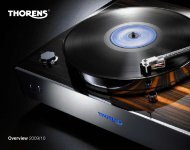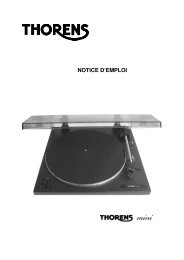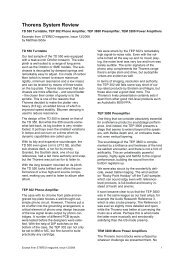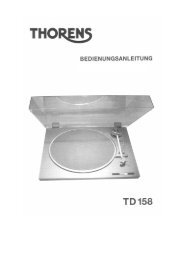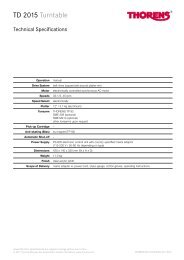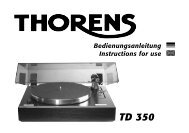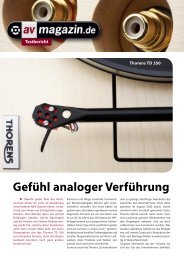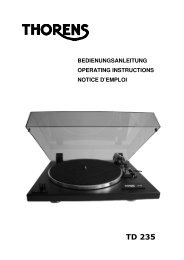Coming Around Again... Thorens TD160HD Turntable
Coming Around Again... Thorens TD160HD Turntable
Coming Around Again... Thorens TD160HD Turntable
You also want an ePaper? Increase the reach of your titles
YUMPU automatically turns print PDFs into web optimized ePapers that Google loves.
from<br />
REPRODUCING THE RECORDED ARTS<br />
2008 BC...<br />
<strong>Thorens</strong> reinvent<br />
the wheel<br />
Issue 56<br />
£4.50<br />
www.hifi plus.com<br />
NEW Digital benchmarks from Muse and AMR<br />
Foot Long...<br />
Tonearms from SME,<br />
Brinkmann, Consonance<br />
Getting Warm...<br />
Karan Acoustics and Audio Research<br />
Speaking In Tongues...<br />
Living large with Spendor’s mighty SP100R
EQUIPMENT REVIEW<br />
<strong>Coming</strong> <strong>Around</strong> <strong>Again</strong>...<br />
<strong>Thorens</strong> <strong>TD160HD</strong> <strong>Turntable</strong><br />
“I know nothing stays the same…” at<br />
least, so sang Carly. But in hi-fi, as in life,<br />
there are touchstones, ever-presents,<br />
whose constancy both reassures and<br />
marks our passage: they may develop<br />
or evolve, fade from our affections only<br />
to re-emerge later, often reminding us<br />
along the way of a reality we’d perhaps<br />
chosen to forget. And let’s be honest,<br />
wanton disregard for the facts is pretty<br />
much a prerequisite for audiophilia<br />
nervosa. Which tends to make products<br />
that are just downright sensible, that<br />
deliver simple, honest performance,<br />
sadly unglamorous. But how often<br />
do we come back to<br />
them, rediscovering<br />
the solid qualities that<br />
somehow escaped our<br />
notice (or didn’t seem<br />
quite so important)<br />
when we were busy<br />
selecting our last flight<br />
of sonic fancy?<br />
<strong>Thorens</strong> supplied my first ever,<br />
suspended sub-chassis turntable (at<br />
a time when suspended sub-chassis<br />
construction was de rigeur if you didn’t<br />
want the staff in your local audio store<br />
sniggering at you behind your back).<br />
That TD160S, complete with an SME<br />
3009 served me well, whilst encouraging<br />
a (probably unhealthy) interest in the<br />
history of the deck’s development. As a<br />
result I also acquired a TD160BC, various<br />
TD150s and a couple of AR XAs, all for<br />
peanuts on the secondhand market. It<br />
was an interesting voyage of discovery,<br />
along the path of which I learnt that<br />
appearances can be deceptive and<br />
newer doesn’t necessarily mean better.<br />
But it also taught me considerable<br />
respect for <strong>Thorens</strong>’ engineering and<br />
by Roy Gregory<br />
their place in the hi-fi firmament,<br />
importers to Europe from its roots in the<br />
US, of the structural approach that was<br />
to sweep to prominence in the audio<br />
equivalent of jihad.<br />
Ironic then, that just as the<br />
suspended deck seems finally to have<br />
had its day, the latest TD160 incarnation<br />
should arrive. But just as <strong>Thorens</strong><br />
themselves have been through a major<br />
transformation, changing ownership<br />
and revisiting the electronics market<br />
with some really rather impressive<br />
power amplifiers,<br />
the TD160<br />
you see before<br />
you today, whilst sharing a basic<br />
concept with its various ancestors,<br />
employs materials, engineering and<br />
execution that have changed out of<br />
all recognition. Look a little closer and<br />
you find a deck that whilst superficially<br />
similar is technologically far more<br />
impressive. But the best bit of all: it’s<br />
simpler, even more sensible, but the<br />
performance now needs no apologies.<br />
Add that to all the techy stuff you can<br />
wax lyrical about and the dear old<br />
TD160 has become downright sexy.<br />
So what have we got? Outwardly<br />
the <strong>TD160HD</strong> employs similar, compact<br />
Reproduced from Hi-Fi+ Issue 56<br />
www.hifiplus.com<br />
plinth dimensions and the same<br />
moulded lid as the original. That’s<br />
where the material similarities cease.<br />
The lid no longer even comes with<br />
hinges – removing the lid whilst playing<br />
being one of the standard tweaks<br />
in ages past. The sub-chassis is now<br />
constructed from RDC material, and<br />
suspended on sophisticated polymer<br />
grommets that provide exceptional<br />
isolation coupled to good mechanical<br />
stability, meaning speed stability is also<br />
improved. Drive is from a slow-speed<br />
synchronous motor, fitted with a large<br />
diameter, crowned profile nylon pulley<br />
and fed from an external,<br />
plug-top supply. This<br />
uses the standard<br />
<strong>Thorens</strong> flat belt to drive<br />
a one-piece acrylic<br />
platter, possibly the<br />
biggest single change<br />
from the original design<br />
with its two-part aluminium<br />
platter. You even get a nifty<br />
little device that enables you to<br />
position the belt correctly. The platter<br />
sits directly on the new, larger-diameter<br />
bearing shaft, supported by a large<br />
cir-clip. The top of the platter surface<br />
is recessed to accept a two-piece,<br />
course cork mat, similar in design to<br />
the Loricraft ones, the large cut-out in<br />
the top layer forming the label recess.<br />
A large switch on the front corner of the<br />
plinth allows electronic selection of 33<br />
and 45 (although personally I’d have<br />
loved to see the old, almond-shaped<br />
knob retained, perhaps in acrylic to<br />
match the platter.<br />
The deck comes supplied with a<br />
<strong>Thorens</strong>-badged Rega RB250 mounted<br />
on its now circular armboard. This is
EQUIPMENT REVIEW<br />
moulded from RDC and incorporates<br />
a locking collar to allow arm-height<br />
adjustment. The armcable is terminated<br />
in a pair of phono sockets mounted in<br />
the rear of the plinth, although no earth<br />
terminal is provided. One final change<br />
that’s definitely for the better; the deck<br />
stands on three RDC cone feet, which<br />
sound better than the old rubber ones<br />
as well as allowing precise levelling.<br />
The factory-set suspension and clear<br />
instructions make set-up as simple as<br />
any solid-plinth design and the biggest<br />
dilemma will be choice of cartridge and<br />
mounting surface. Although the <strong>Thorens</strong><br />
is less affected by its support than some<br />
suspended designs, it will still benefit<br />
from some care in this regard and I got<br />
excellent results from Cambre Core<br />
and finite-elemente racks as well as the<br />
(completely overkill but I just had to<br />
try it) Grand Prix Audio wall shelf.<br />
The Rega arm will be at home<br />
with anything from budget<br />
moving-magnets up to<br />
sub-£1K coils from Lyra,<br />
Ortofon or Dynavector.<br />
<strong>Again</strong>, I got great results<br />
using a DV-20X but the<br />
player really deserves<br />
(and rewards the use of) a better<br />
cartridge, and I employed the Lyra Argo<br />
for much of my listening – although I’ve<br />
a sneaky suspicion that the DV-17D3<br />
could work really well too.<br />
The complete package (without<br />
a cartridge but including a basic<br />
interconnect for the tonearm, a small<br />
spirit level and a really excellent<br />
instruction manual) will set you<br />
back £1395, which I have to judge a<br />
What on earth is RDC?<br />
considerable bargain. Incidentally, you<br />
can also buy the <strong>TD160HD</strong> as a BC (or<br />
basic chassis) model, fitted with a Rega,<br />
SME M2, SME oval or blank armboard<br />
at a price of £1250. Other factory fitted<br />
combinations include the RB300 at<br />
£1470, the SME M2/9 at £2500 or the<br />
SME 309 at £2800.<br />
In serious analogue terms the<br />
price of the <strong>TD160HD</strong> with the RB250<br />
represents one step up from entry level,<br />
the bottom rung on the high-end ladder.<br />
However, that doesn’t mean that you<br />
can take its performance for granted.<br />
Care and attention to meticulous setup<br />
pays dividends, and whilst this is<br />
mainly a case of doing it properly and<br />
checking that you have (rather than any<br />
arcane black arts), time spent getting the<br />
deck perfectly<br />
level, aligning<br />
the cartridge – ideally more<br />
accurately than the provided Rega<br />
single-point protractor allows – and<br />
getting cabling and a nice clean mains<br />
feed is readily audible in the musical<br />
end result. In particular, pay attention to<br />
tracking force. Set it initially (preferably<br />
using an electronic balance) but then<br />
For all of you who’ve been asleep at the back, RDC is a resin-based material developed by a German<br />
company Clearlight Audio, containing grains of different sizes and materials that bonded together<br />
create a chaotic and thus non-resonant structure. Readily moulded into different, complex shapes<br />
and also easily machined, the nature of the substance’s mechanical behaviour can be further tuned<br />
according to the precise mix of materials incorporated. It has enjoyed considerable success in the<br />
accessories markets as well as delivering impressive results in Clearlight’s own products. The <strong>Thorens</strong><br />
<strong>TD160HD</strong> was developed with considerable input from Clearlight’s Kurt Olbert, and is the first massmarket<br />
product to really exploit the material.<br />
Reproduced from Hi-Fi+ Issue 56<br />
www.hifiplus.com<br />
take the trouble to listen to the effect of<br />
tiny adjustments up and down. Do it by<br />
ear, simply turning the weight a mil or so<br />
each time. You’ll soon hit a sweet spot<br />
that combines pace and a solid sense<br />
of purpose to the music. Over do it and<br />
things will start to slow and get stodgy.<br />
It makes all the difference between a<br />
performance that’s nice, and one that<br />
really grabs and holds your attention<br />
– and it’s free. Which in many respects<br />
sums up the <strong>Thorens</strong> as far as set up<br />
goes. Plug and play it straight from the<br />
box and you’ll get a performance that’s<br />
perfectly respectable, especially at the<br />
price. Do the job properly and you’ll<br />
elevate that performance significantly,<br />
adding transparency, dynamic range,<br />
solidity and a natural sense of musical<br />
flow to proceedings.<br />
Running the <strong>TD160HD</strong><br />
with the Argo mounted<br />
and a Crystal arm cable<br />
(chosen to match the<br />
rest of the cabling in<br />
the system rather than<br />
the deck specifically)<br />
the performance<br />
delivered was<br />
frankly astonishing<br />
for the money.<br />
Like its principal<br />
competitor, VPI’s<br />
Scout, the TD160<br />
completely redefines<br />
your expectations as to just how<br />
much music you can get from a basic<br />
analogue set-up. Compared to the more<br />
affordable offerings from Rega and<br />
ProJect this is definitely the real deal.<br />
The dynamic envelope, bandwidth,<br />
transparency and range of expression<br />
available puts many a high-end CD<br />
player to shame – and quite a few<br />
wannabe turntables too. There’s an<br />
attractive pace and momentum to<br />
music that demands it, a more relaxed<br />
ease and expansive fluidity to more<br />
introspective material. So KT Tunstall’s<br />
‘Black Horse And The Cherry Tree’ has<br />
an infectious bounce and drive that<br />
picks up effortlessly from the more
EQUIPMENT REVIEW<br />
reflective,<br />
stretched-out<br />
tempo of ‘Under<br />
The Weather’. Rock solid drums propel<br />
the track, easily bridging the hesitations<br />
and breaks that keep things interesting<br />
across the length of this perfectly<br />
shaped mini-pop statement. Yet the<br />
music slips just as effortlessly into<br />
the tactile, almost reggae bass line of<br />
‘Miniature Disasters’ with its deep, deep<br />
thuddy bass drum. Too many decks roll<br />
the rhythms of these successive tracks<br />
together, making them sound same-y<br />
when in reality they’re far from it. It’s<br />
this chameleon quality that underpins<br />
the stellar musical contribution of the<br />
<strong>Thorens</strong>, that allows it to put the music<br />
so firmly first. It has an innate, almost<br />
preternatural grasp of music’s rhythm<br />
and tempo, and an ability to match its<br />
pace – and shifts in pace – that allows<br />
it to live and breathe. This should come<br />
as no surprise to anybody who has<br />
heard the Clearlight turntables – but<br />
here, combined with the cost benefits<br />
of (relatively) large-scale production<br />
we discover the benefits at<br />
a previously undreamt of<br />
price-point. And there’s more:<br />
couple the deck’s plug-top<br />
power supply into something<br />
more sophisticated like a mains<br />
regenerator feeding the rest of the<br />
system, and its temporal grasp becomes<br />
absolutely front-rank, matching any<br />
‘table I’ve heard in this important<br />
respect – making for a compellingly<br />
enjoyable listening experience.<br />
You’ll also notice that thus far,<br />
the only record I’ve referred to is a<br />
bog-standard commercial pressing<br />
of a far from great<br />
recording. The best<br />
thing about<br />
the TD160’s<br />
inherent<br />
honesty, its<br />
reluctance<br />
to step<br />
forward<br />
in the process, is<br />
that it allows records to<br />
speak for themselves rather than<br />
standing over them, pointing out their<br />
shortcomings. Likewise, as wonderful as<br />
the Argo sounded, the DV-20X, at almost<br />
a quarter of the price, was allowed to<br />
strut its stuff, sounding well-balanced,<br />
grainless and sweetly solid. With the<br />
Dynavector installed the ‘table took<br />
on a smaller, slightly politer and more<br />
constrained quality. It didn’t sound saton<br />
or shut-in, it sounded complete and<br />
satisfying. Reverting to the Argo, the<br />
benefits were hard to miss, it’s just that<br />
they made much more sense, were far<br />
more apparent going up the scale than<br />
down – which is another way of saying<br />
that the <strong>Thorens</strong> will generally deliver<br />
as much as it can. So the catchy energy<br />
of ‘Suddenly I See’ has a propulsive<br />
integrity with the DV-20X that pushes<br />
things along, a coherent flow. With the<br />
Argo the carefully woven strands and<br />
textures,<br />
the overdubs<br />
and changes in density<br />
are teased out, more apparent, adding<br />
interest and subtlety to the song. But this<br />
isn’t just about the cartridges; it’s about<br />
the deck allowing them to do their job.<br />
This evenhandedness is a mark<br />
Reproduced from Hi-Fi+ Issue 56<br />
www.hifiplus.com<br />
of the deck’s inherent, almost studied<br />
neutrality. It imposes so little of itself<br />
on the process that its partnering<br />
equipment and the recorded content<br />
dominate proceedings. <strong>Again</strong> it’s a case<br />
of the RDC hallmark, with a naturally<br />
effortless separation of instruments and<br />
overall clarity that sets out a convincing<br />
soundscape without paring away the<br />
instruments to etched outlines of their<br />
solid selves. That is in turn down to the<br />
tonal and textural distinction the deck<br />
brings to individual instruments and<br />
notes, its harmonic patterns underpinned<br />
by micro-dynamic integrity and the<br />
even nature of its energy spectrum.<br />
There are no bands of unwanted colour<br />
to clog proceedings, no excess weight<br />
wobbling embarrassingly free where<br />
it’s least expected. Instead, the picture<br />
presented is clean and unadulterated,<br />
what sins there are being subtractive in<br />
nature. These are apparent in a subtle<br />
greying of the tonal palette, although<br />
not one that diminishes instrumental<br />
separation or identity. Instead it serves<br />
to mute the more vivid aspects of their<br />
tonal character. This and the limits<br />
on absolute low-frequency resolution<br />
and transparency (a lack of acoustic<br />
boundaries and the air below bass<br />
instruments, only apparent when<br />
compared to far more costly ‘tables)<br />
and some congestion or lack of poise<br />
on the most complex and energetic<br />
material are I suspect, more a product<br />
of the tonearm than the deck. Of<br />
course, a better arm alters<br />
the cost and value<br />
balance, but<br />
the inherent<br />
dynamic,<br />
bandwidth and<br />
tonal limitations of<br />
the Rega beg the question<br />
as to just how good a platform the<br />
<strong>TD160HD</strong> provides? Hopefully, it’s a<br />
question we can investigate further<br />
via the BC model, but for now, it’s the<br />
<strong>Thorens</strong>/Rega pairing that concerns<br />
us, and at the asking price the failings<br />
are frankly trivial.
EQUIPMENT REVIEW<br />
Playing better recordings simply<br />
plays to the deck’s strengths. The<br />
Carmen Fantasie on Decca? Space, air,<br />
focus, a calm assurance and mid-band<br />
transparency combine with the delicate<br />
precision of Ricci’s playing to captivate<br />
the listener. Dynamic contrasts may fall<br />
short of the TNT 6 carrying the Titan i,<br />
but only by dint of extreme familiarity<br />
or direct comparison, while the subtle<br />
shifts in tempo and beautiful phrasing<br />
of soloist and strings are given full<br />
rein. The confident swagger in Ricci’s<br />
bowing never runs away, transforming<br />
itself into hauteur or vivid drama at<br />
the demand of conductor and score.<br />
This ability to embrace the emotional<br />
compass of a performance is exactly<br />
why you should invest in analogue in<br />
the first place. The <strong>Thorens</strong> delivers<br />
a more immediate return on your<br />
investment than any other deck I’ve<br />
tried near the price.<br />
Nor does it favour one genre at<br />
the expense of others.<br />
Listening to the likes of KT Tunstall or<br />
The Cure you could be forgiven for<br />
concluding that its pace and drive make<br />
it a rock or pop orientated product.<br />
But nothing could be further from the<br />
truth. The restrained tempo of Sarasate’s<br />
Zigeunerweisen, the elongation of the<br />
phrases, is never hurried or clipped.<br />
Music, all music is allowed to breathe;<br />
yet that that should be breathless<br />
is breathless indeed. It’s a little like<br />
watching a great middle-distance runner<br />
going through his paces. A perfect blend<br />
of balance, grace and honed, athletic<br />
power, there’s a sense of contained<br />
energy waiting to respond or explode<br />
as required. Think of the poise and<br />
effortless acceleration of Seb Coe in his<br />
prime, all that potential performance<br />
contained in such a slight frame, yet<br />
combined with the vivacious life and<br />
graceful bounce of a ballet dancer.<br />
That’s the surefooted musical response<br />
you get from the <strong>Thorens</strong>; and some of<br />
Coe’s World Records still stand today!<br />
Just how good is the <strong>TD160HD</strong>’s<br />
motor unit? I’ve yet to discover, but<br />
I’ve also yet to push it beyond its limits.<br />
Even a combination of Connoisseur<br />
phono and line stages driving the VAS<br />
amps and Wilson’s Duette/WATCH<br />
Dog combination failed to disturb its<br />
balanced enthusiasm or calm restraint,<br />
simply extracting more and more<br />
performance from the player. Likewise,<br />
the way it responds to external<br />
upgrades, be they a cartridge, a power<br />
supply or a support, further suggests the<br />
mechanical integrity of the essentially<br />
simple but beautifully executed design.<br />
And all at a price that is distinctly Real<br />
World. I’m pondering where to go in<br />
terms of a<br />
matching<br />
arm: the<br />
Naim ARO<br />
is an obvious<br />
contender,<br />
as is the<br />
Kuzma Stogi<br />
Reference, whilst VPI’s<br />
JMW 9.0 also appeals. Then there’s<br />
the Brinkmann 10” if that would fit.<br />
Choices, choices…<br />
But let’s try and put the <strong>Thorens</strong> into<br />
some sort of context. As appealing as<br />
it should be to anybody looking for a<br />
high value record player, just consider<br />
the special fascination it will hold for<br />
all those who owned, once aspired to<br />
own, or still own a Linn. Just think; you<br />
could buy a Keel sub-chassis upgrade<br />
for an LP12 or, for around half the price,<br />
a whole new deck to mount an existing<br />
or new arm on – leaving you around a<br />
£1000 to spend on peripherals, and we<br />
Reproduced from Hi-Fi+ Issue 56<br />
www.hifiplus.com<br />
know how this deck responds to those!<br />
Am I really suggesting that the 160 is a<br />
viable alternative to a fully loaded Linn?<br />
I don’t know, not having heard the latest<br />
LP12, but I’m confident that the <strong>Thorens</strong><br />
will give any of the previous Linn<br />
incarnations a run for their money. Yes,<br />
the <strong>TD160HD</strong> really is that good. In fact,<br />
this <strong>Thorens</strong> has to represent one of the<br />
biggest analogue bargains of all time.<br />
Given the dedicated following that still<br />
clings to the Linn and the stratospheric<br />
price rises on that product, let alone all<br />
the analogue newbies and born-agains,<br />
the <strong>TD160HD</strong> could (and should)<br />
be the most significant analogue<br />
product launched in the UK this<br />
year. Suddenly, being sensible seems<br />
almost… sensible!<br />
TECHNICAL SPECIFICATIONS<br />
Type: Record player with<br />
suspended sub-chassis<br />
and integral Rega<br />
tonearm<br />
(other arms available<br />
– see text)<br />
Motor: AC synchronous<br />
Drive: Belt<br />
Speeds: 33 and 45<br />
Platter: One-piece acrylic<br />
Platter Weight: 2kg<br />
Tonearm: Rega RB250<br />
Effective Length: 223mm<br />
Dimensions (WxHxD): 430 x 175 x 340mm<br />
Weight: 8kg<br />
Finish: Black/Grey<br />
Guarantee: 2 years<br />
Number Of UK Dealers: 30<br />
Price: £1395 (including<br />
RB250 tonearm)<br />
UK Distributor:<br />
UKD<br />
Tel. (44)(0)1753 652669<br />
Net. www.ukd.co.uk<br />
Manufacturer:<br />
<strong>Thorens</strong> Export Co. Ltd.<br />
Net. www.thorens.com



